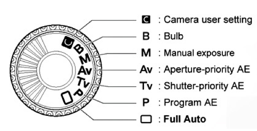Photography Tutorial
Quick guide to using a DLSR camera
A DSLR or Digital Single Lens Reflex is simply a digital camera with mirror mechanism that allows you to see directly through the lens when using the viewfinder. Since DSLR are generally intended for advanced users, they allow much more precise control than regular cameras. When using the DSLR you can control how much light enters the camera through the lens aperture and the shutter speed. Knowing how to adjust these settings allows you to change the nature and style of the photo in a very controlled way. In addition to aperture and shutter speed, DSLRs allow you to make several adjustments to how the photo is digitally processed.
Since most modern DSLR make fantastic video, learning to use one not only makes you a better photographer, but also a better videographer.
Mode Dial
Most DSLR cameras, and many regular cameras are fitted with a mode dial to quickly select image modes.
M
In manual mode the user controls all settings.
Av or A
In Aperture Priority the photographer adjusts the aperture, and the camera automatically adjusts other settings to get a correct exposure.
Tv or S
In Shutter Priority the photographer adjusts the shutter speed, and the camera automatically adjusts other settings to get a correct exposure.
Auto
Completely automatic…
P
Program mode is a thinking person automatic, the photographer can change some settings, then camera automatically adjusting the rest.
B
In Bulb mode the photographer controls the shutter speed directly by pressing to open the shutter releasing to close it. This can be useful for very long exposures, or when using an external flash to control how long light enters the camera.
Aperture (f/value)
- The aperture of the lens is the diameter of the lens opening
- The larger the diameter, the more light reaches the image sensor
- The smaller the f-stop, the wider the aperture
- If you use faster shutter speeds (i.e 1/200+) to capture fast action, you will generally need to use a wider aperture
- The wider the aperture the shallower the depth of field: the area in focus becomes narrow
- The closer the subject to the lens in relation to the background, the narrower the depth of field will appear
Depth of field: the length of the filed where objects are in focus
Direct the attention within the photo – Use a wide aperture for a narrow depth of field. This forces the viewer’s attention to the area in focus.
Allows the viewer to explore complex scenes – Use a high f-stop (a very small aperture f/22) to capture everything in focus. This allows the viewer to explore the scene completely.
Shutter speed (second/fraction)
- Shutter speed controls the time that light hits the image sensor
- Use a fast shutter speed to capture fast moving objects (greater than 1/250)
- Camera shake is more evident with greater focal lengths. As a rule of thumb, don’t use a shutter speed that is any slower than the value of the focal length without a tripod i.e no slower than 1/40 with a 40mm lens
- A slower shutter speed needs a narrow aperture to avoid overexposure (or use a lens filter to darken the scene)
Creating sense of movement – slow shutter speed can be effective with moving crowds, flowing water etc. to creating a sense of flow and movement.
Correct Exposure tips
- To 'freeze' fast action, you need to use a fast shutter speed
- A slow shutter speed requires a tripod, or something to rest the camera on
Exposure Bracketing
Use Exposure Bracketing to ensure proper exposure of pictures, especially in difficult or unusual lighting situations:
- Snow or bright backgrounds can be difficult; you may need to overexpose the background to correctly exposing the main subject. Flash can be helpful in this setting to match the exposure of the subject with the bright background
- Dark scenes - under expose the photo slightly for better results (-1/3EV)
- Sunset - Slightly under expose the photo for more vibrant colors
Focal Length (zoom)
Focal length is simply a measure of the zoom available with a particular lens or camera.
- A shorter focal length (wide) means a wider shot i.e you can get more of the scene in view
- A longer focal length (telephoto) allows you to see details from a distance
- The higher the focal length, the more evident camera shake will become
- Wider lenses have the effect of amplifying the appearance of depth and perspective i.e. they can make small rooms look big and short people look tall. This can sometimes make photos look unreal or distorted, but this can also be used for effect
- Telephoto lenses tend to flatten and reduce perspective; this can make them useful for bringing the background closer to the subject
- The canon 5D is a full frame camera, meaning the sensor size is the equivalent of 35mm film. Many DSLRs are cropped, or non-full frame meaning that the sensor area is smaller resulting in cropped images. These cropped photos have the appearance of a longer focal length then a full frame camera.
ISO
Is a software adjustment for the sensitivity of the image sensor.
- Increasing the ISO setting allows photos to be taken in low light conditions
- Increasing the ISO results in noise in the image, so it’s best to optimize the aperture and shutter speed for the situation before increasing the ISO setting
Noise:
* A longer exposures can introduce noise on digital cameras
* A higher ISO introduces noise
* Noise can be reduced in Photoshop or Lightroom but it does have limits…
Camera RAW
The camera RAW format is an uncompressed file format that allows the photographer more powerful editing possibilities after taking the photo. Settings like white balance are easer to correct with RAW.


